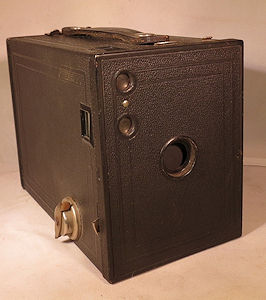The rectangular format for the Number-2 Brownie was specified to have a diagonal
of exactly 100 mm and a width of 57 mm (2¼''
rounded down).
By the theorem of Pythagoras,
the nominal height of the picture is equal to:
Ö ( 1002 - 572 ) =
Ö 6751 = 82.1644692...mm.
Accurate measurements on my own Brownie confirm this.
The advertised size of 2¼'' by 3¼''
is definitely just a rough approximation...
This image size had been inaugurated in August of 1897
with the Folding Pocket Kodak
(on 105 roll-film, discontinued in 1949)
which Frank A. Brownell
(1859-1937) designed and manufactured for Kodak.
In 1898, George Eastman commissioned Brownell to design what would become
the Brownie cameras: Affordable easy-to-use cameras which would
encourage everybody to practice photography, thereby
increasing film sales for the Eastman Kodak Company...
Officially at least, the Brownie camera wasn't named after Brownell but
after the cartoon characters "The Brownies" created in 1879 by
Palmer Cox (1840-1924).
The lens was precisely a normal one, according to the wisdom of that era,
with a focal length exactly equal to the diagonal of the picture (100 mm).
With such a lens focused to infinity, a camera would have a field of view of 53.13°.
However, to maximize its depth of field,
the fixed-focus of the No.2 Brownie was set to the
hyperfocal distance instead,
which narrows its field of view by one or two degrees.
I measured the diameters of the three apertures on my No.2 Brownie to be
approximately 3.5 mm, 5 mm and 7 mm.
These are obviously one f-stop apart.
Beginner's question
|
f-stop equivalents on a Kodak Brownie No.2




